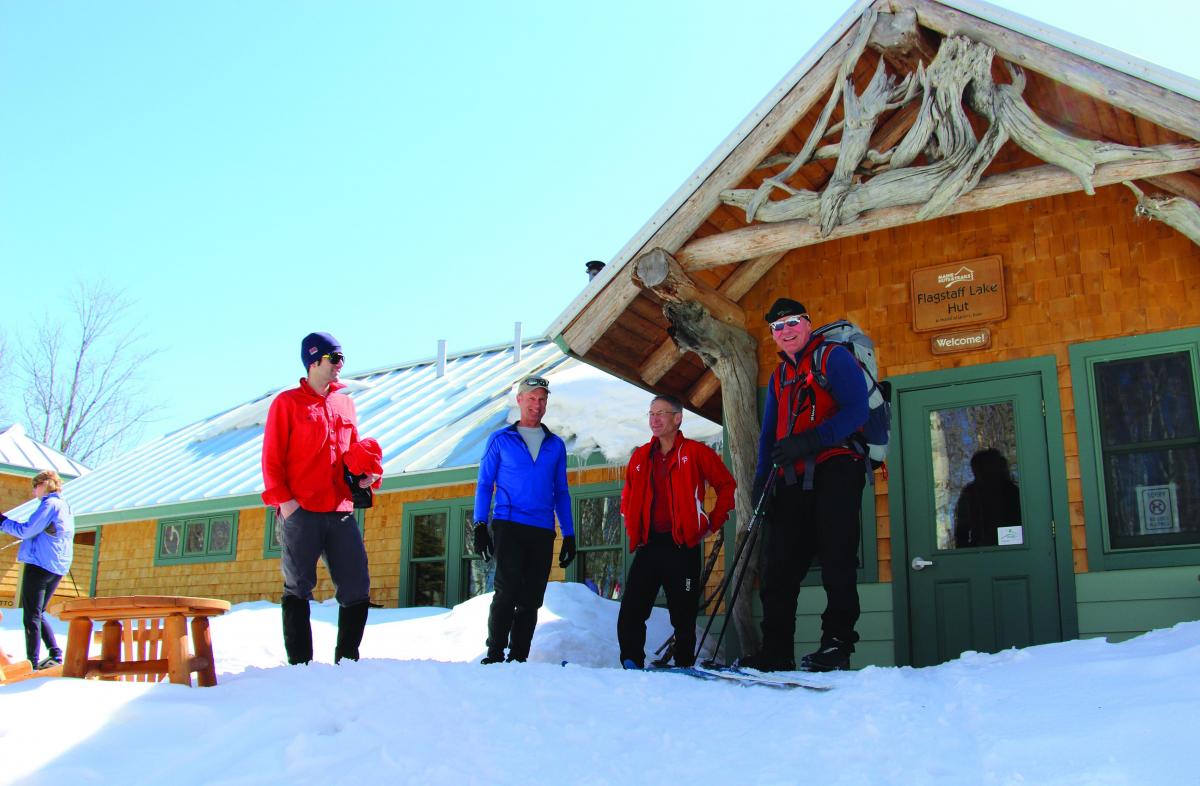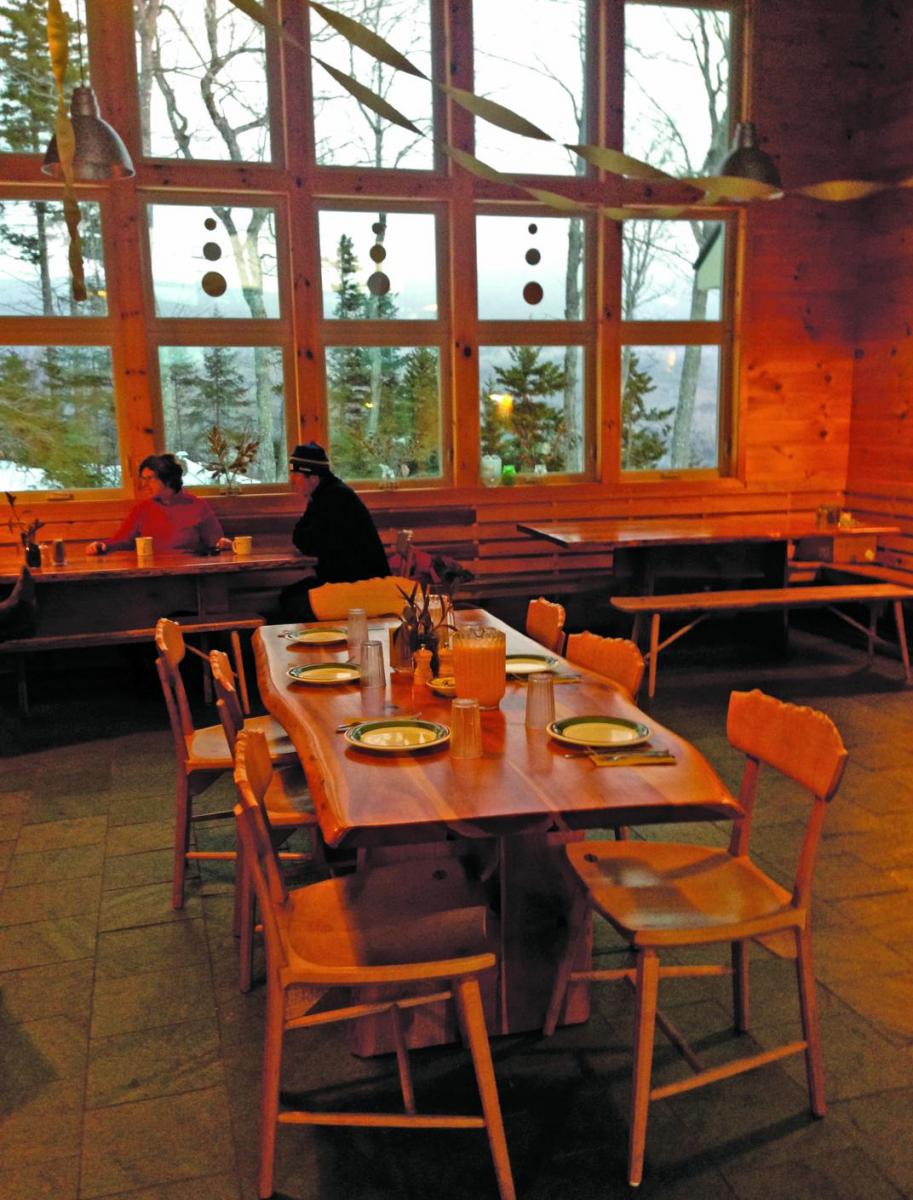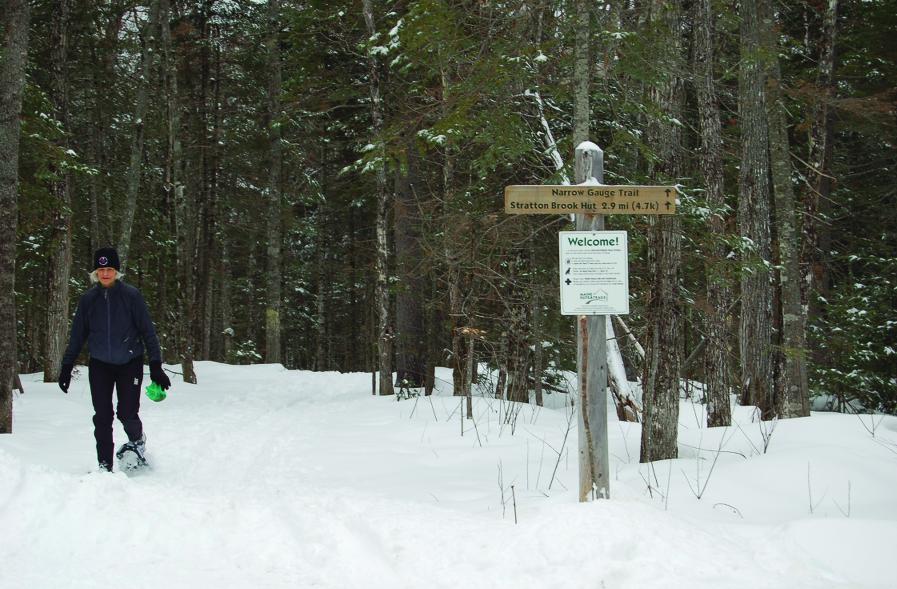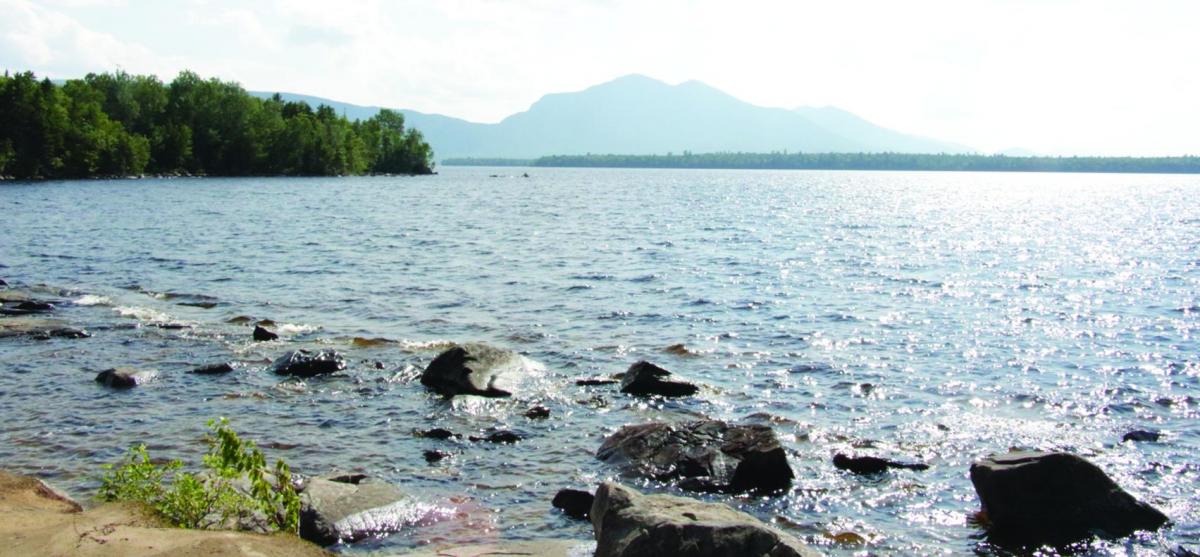What’s wonderful about un-motorized travel on the trails and lakes of Maine’s western mountains is self-evident: the scenery is glorious and varied, the air is pure, nature is pristine, and the nighttime silence is profound. It’s why legions have headed here for generations to hike, snowshoe, mountain bike, paddle, and cross-country ski.
What’s less wonderful is the hard work an overnight outing requires, including cooking over fires, pitching camp, sleeping on the ground and in tents and, perhaps most daunting of all, carrying all the requisite food and gear.
 Maine Huts and Trails maintains miles of paths for skiing, hiking, or even biking between beautiful lodges in Maine’s wilderness. The organization transports client gear between lodges, and provides a welcome respite at the end of each day’s trek. Here, skiers prepare to set out from the Flagstaff Lake Hut. Courtesy Maine Huts and Trails
Maine Huts and Trails maintains miles of paths for skiing, hiking, or even biking between beautiful lodges in Maine’s wilderness. The organization transports client gear between lodges, and provides a welcome respite at the end of each day’s trek. Here, skiers prepare to set out from the Flagstaff Lake Hut. Courtesy Maine Huts and Trails
Now we can have the wonderful without the work: an organization called Maine Huts and Trails offers beautifully groomed trails year-round while also providing delicious hot meals, glasses of wine, hot showers, real bedrooms, comfy sofas, and conviviality by the fire. And, they even haul your gear. It’s enough to make a couch potato strap on hiking boots and head out on the trail.
A recent snowshoe expedition to the Stratton Brook Hut, located at an elevation of 1,900 feet above the Carrabassett Valley, began with a stop at a small shed near the trailhead off Route 27. This scenic byway takes drivers north from Kingfield, past Sugarloaf Mountain, through the Chain of Ponds and to the Canadian border.
My fellow trekkers and I found the drop-off point near the runway of the Carrabassett Valley Regional Airport, where we happily dumped our sleeping bags and backpacks. Encumbered only with water bottles and sunscreen, we began snowshoeing on a wide trail leading though deep evergreen forest. Within moments, houses and cars faded from sight and sound.
 The edge of the wood on the back of the chairs in the dining area at the Stratton Brook Hut mirrors the profile of the mountains in the Bigelow Range, visible from the window. Photo by Regina Cole The 180-mile corridor between the Mahoosucs (a small mountain range near Bethel) and Moosehead Lake is incredibly rich with natural assets, said Maine Huts and Trails Executive Director Charlie Woodworth. “The logging industries that created the small towns of the area have vanished,” he said, “and land that used to be owned by a few large corporations has broken up into networks of public and private ownership.”
The edge of the wood on the back of the chairs in the dining area at the Stratton Brook Hut mirrors the profile of the mountains in the Bigelow Range, visible from the window. Photo by Regina Cole The 180-mile corridor between the Mahoosucs (a small mountain range near Bethel) and Moosehead Lake is incredibly rich with natural assets, said Maine Huts and Trails Executive Director Charlie Woodworth. “The logging industries that created the small towns of the area have vanished,” he said, “and land that used to be owned by a few large corporations has broken up into networks of public and private ownership.”
The brainchild of former Sugarloaf ski area Chief Operating Officer Larry Warren, Maine Huts and Trails was inspired by similar ventures in Europe and New Zealand. There the word “hut” does not mean that the accommodations are primitive or uncomfortable; rather the defining characteristic is that you can’t drive to them.
“With a non-profit in the hospitality business, we are creating environmentally sensitive economic development,” Woodworth explained. “Through careful design and the use of environmentally friendly technologies, our accommodations have a carbon-neutral footprint. We have completed Phase One with four lodges, or huts, along a 50-mile section of interconnecting trails. Our objective is to eventually have 12 huts.”
The organization opened its first hut, the Poplar Hut, in 2008.
The Maine Huts and Trails organization utilizes existing trails as well as creating new ones. For new trails, much of the company’s effort goes toward procuring easements from private landowners. Eventually they hope to provide access to hundreds of miles of trails between Kingfield, Moosehead Lake, and the Rangeley Lakes areas.
Some huts are reached by water. “You can paddle to the Flagstaff and Grand Falls huts,” said Woodworth. “People don’t expect it and, when they see it, love it!”
 The trails are used by people on snowshoes as well as cross-country skiers. Photo by Regina Cole After traveling about a mile on the Narrow Gauge Pathway, one of the organization’s long-established trails, our small group turned onto the Oak Knoll Trail. Another mile or so brought us to a fork where the Newton’s Revenge Trail branches off to the right. Switchbacks make the Oak Knoll Trail easier, but longer. Motivated by thoughts of dining, wining, and lounging, we took the shorter route.
The trails are used by people on snowshoes as well as cross-country skiers. Photo by Regina Cole After traveling about a mile on the Narrow Gauge Pathway, one of the organization’s long-established trails, our small group turned onto the Oak Knoll Trail. Another mile or so brought us to a fork where the Newton’s Revenge Trail branches off to the right. Switchbacks make the Oak Knoll Trail easier, but longer. Motivated by thoughts of dining, wining, and lounging, we took the shorter route.
We never saw the Stratton Brook Hut until we stepped into the forecourt. Set atop a small peak between Sugarloaf Mountain and the Bigelow Range, the newest of the huts is an appealing timber and glass building connected to a bunkhouse by a covered walkway. Designed by John Orcutt, a Kingfield architect who is also a nature photographer, the main building has a kitchen, showers, lavatories and a lavatory-shower combination for handicapped users. The common area is a wood-lined great room with twin wood stoves, triple-glazed windows on two sides, leather armchairs and sofas, a dining area that seats 48, and a soaring ceiling. Radiant heat under the Monson slate flooring here and in the bedrooms comes from a wood-fired boiler, the toilets are composting, and solar panels provide electricity and hot water.
“Each of our four huts has its own particular personality,” Woodworth said. “The Stratton Brook hut is alpine. The Poplar Hut is in a wooded area, near waterfalls. The Flagstaff Hut is on the lake and the Grand Falls Hut is down the Dead River, the most remote hut.”
The various huts are designed to keep low profiles amid the scenic splendor. Just as the Stratton Brook Hut was hidden until we came upon it, the Flagstaff Lake Hut provides spectacular lake views, but is invisible from the lake itself.
Our gear, delivered via snowmobile shuttle, awaited us, so we changed into dry clothes and settled in. Dinner, served family style, featured vegetarian as well as meat courses and was delicious and filling. In lieu of staring at screens after dinner, as so many of us do when at home, we toured the facility, played Bananagrams, chatted, perused the library, and relaxed by the fire. There were no outlets for charging cell phones: the roof-mounted solar array makes only DC (direct current) power.
 The trail network also gets quite a bit of use in the warmer months. The Flagstaff Lake Hut has canoes and kayaks available. Photo courtesy Maine Huts and Trails
The trail network also gets quite a bit of use in the warmer months. The Flagstaff Lake Hut has canoes and kayaks available. Photo courtesy Maine Huts and Trails
Breakfast was hearty and nourishing, augmented by dramatic scenery unfolding in the morning light. A large triptych photograph of the Bigelow Range by John Orcutt dominates one wall and echoes the view to the east. Windows facing west take in the ski trails on Sugarloaf Mountain.
As everyone’s favorite gear shuttle whisked away our sleeping bags and backpacks, we made lunches from a generous spread and prepared to head out to the trail again. But first our guide, Maine Huts and Trails Recreational Director Lani Cochrane, took us on a slight detour to a clearing atop a nearby knoll. Speechless, we gazed at mountains and valleys unspoiled by signs of humanity.
Later when our group headed back downhill toward our cars and civilization, we saw another group headed out on a seven-mile trail to the Poplar Hut for an overnight stay.
We were envious as we watched them go.
Regina Cole is a freelance writer living in Gloucester, Massachusetts. She writes about architecture, interior design, and the history of the American decorative arts for many national and regional magazines.
Maine Huts and Trails can be reached at 207-265-2400 or at www.mainehuts.org. Pricing is per-person and varies based on season; entire lodges can be rented for groups. Check the website for prices and availability.
The Appalachian Mountain Club of Maine also offers wilderness camping lodges with access to 80 miles of trails. www.outdoors.org/lodging






